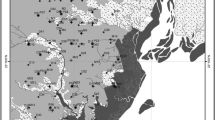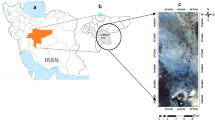Abstract
In this paper, an attempt has been made to propose a generalized correlation between shear wave velocity (Vs) and SPT-N values for all soil types for generalized depth using the concepts of regression. Around 40 correlations have been compiled and applied for estimating the shear wave velocity (Vs) correlation for the region and also to address the uncertainty issue. The generated correlation is then used for the computation of Vs for one-dimensional (1D) ground response analysis at two different site locations in Indore region. 1D ground response analysis is performed using DEEPSOILv6.1. Soil profiles at site taken as input for analysis were collected from 245 boreholes at 26 different locations in the Madhya Pradesh region (one of the central states in India), and it can be concluded that Vs–N correlations estimated after reducing the errors applying the multilinear perceptron and generalized regression neural network models using MATLAB coding gave better results over the linear regression analysis applied for the site-specific ground response analysis.





















Similar content being viewed by others
References
Anbazhagan P, Kumar A, Sitharam TG (2013) Seismic site classification and correlation between standard penetration test N value and shear wave velocity for Lucknow City in Indo-Gangetic Basin. Pure appl Geophys 3(170):299–318. https://doi.org/10.1007/s00024-012-0525-1
Boominathan A, Dodagoudar GR, Suganthi A, Maheshwari R, Uma (2006) Seismic hazard assessment considering local site effects for microzonation studies of Chennai city. In: Proceedings of microzonation a workshop at Indian Institute of Science, Bangalore, India. pp 94–109
Shreyasvi C, Badira Rahmath N, Venkataramana K (2019) Influence of variabilities in input parameters on seismic site response analysis. Lecture notes civil engineering. Springer (in Press)
Hanumanthrao C, Ramana GV (2008) Dynamic soil properties for microzonation of Delhi, India. J Earth Syst Sci 117:719–730
Rao KS, Satyam N (2007) Liquefaction studies for seismic microzonation of Delhi region. Curr Sci 92(5):646–654
Anbazhagan P, Sitharam TG, Divya C (2007) Site response analysis based on site specific soil properties using geotechnical and geophysical tests: correlation between Gmax and N60.4. In: International conference on earthquake geotechnical engineering, no. 1286. p 12
Mhaske S, Choudhury D (2010) GIS-based soil liquefaction susceptibility map of Mumbai city for earthquake events. J Appl Geophys 70(3):216–225
Sitharam TG, Vipin KS (2009) Seismic soil liquefaction based on in situ test data. In: Indian geotechnical conference. pp 857–864
Shreyasvi C, Venkataramana K, Chopra S (2019) Local site effect incorporation in probabilistic seismic hazard analysis—a case study from southern peninsular India, an intraplate region. Soil Dyn Earthq Eng 123:381–398. https://doi.org/10.1016/j.soildyn.2019.04.035
Raghukanth STG, Iyengar RN (2007) Estimation of seismic spectral acceleration in Peninsular India. J Earth Syst Sci 116(3):199–214. https://doi.org/10.1007/s12040-007-0020-8
Narayan R, Sahu RB (2012) Site specific ground motion simulation and seismic response analysis for microzonation of Kolkata. Geomech Eng 4(1):1–18. https://doi.org/10.12989/gae.2012.4.1.001
Lee SH (1990) Regression models of shear wave velocities in Taipei basin. J Chin Inst Eng 13:519–532. https://doi.org/10.1080/02533839.1990.9677284
Chatterjee K, Choudhury D (2016) Influences of local soil conditions for ground response in Kolkata city during earthquakes. Proc Natl Acad Sci India Sect A Phys Sci 88:1–14
Park CB, Miller RD, Xia J (1999) Multichannel analysis of surface waves. Geophysics 64(3):800–808. https://doi.org/10.1190/1.1444590
Shiuly A, Narayan R (2018) A generalized VS–N correlation using various regression analysis and genetic algorithm. Acta Geod Geophys 53(3):479–502. https://doi.org/10.1007/s40328-018-0220-5
Mhaske S, Choudhury D (2011) Geospatial contour mapping of shear wave velocity for Mumbai City. Nat Hazards 59:317–327. https://doi.org/10.1007/s11069-011-9758-z
Kirar B, Maheshwari BK, Muley P (2016) Correlation between shear wave velocity (vs) and SPT resistance (N) for Roorkee region. Int J Geosynth Ground Eng. https://doi.org/10.1007/s40891-016-0047-5
Central Ground Water Board, Ministry of Water Resources, NCR Bhopal (2013) District ground water information booklet of Indore district, Madhya Pradesh. http://cgwb.gov.in/District_Profile/MP/indore.pdf
Neslihan Seckin, Cobaner M, Yurtal R, Haktanir T (2013) Comparison of artificial neural network methods with L-moments for estimating flood flow at ungauged sites: the case of East Mediterranean River Basin, Turkey. Water Resour Manag 27(7):2103–2124. https://doi.org/10.1007/s11269-013-0278-3
Hashash YMA, Musgrove MI, Harmon JA, Groholski DR, Phillips CA, Park D (2016) DEEPSOIL 6.1, user manual. Urbana, IL, Board of Trustees of University of Illinois at Urbana-Champaign
Thokchom et al (2017) Empirical correlation of SPT blow counts versus shear wave velocity for different types of soils in Dholera. Western India. Nat Hazards 86(3):1291–1306. https://doi.org/10.1007/s11069-017-2744-3
Sil A, Haloi J (2017) Empirical correlations with standard penetration test (SPT)-N for estimating shear wave velocity applicable to any region. Int J Geosynth Ground Eng. https://doi.org/10.1007/s40891-017-0099-1
Chatterjee K, Choudhury D (2013) Variations in shear wave velocity and soil site class in Kolkata city using regression and sensitivity analysis. Nat Hazards 69(3):2057–2082. https://doi.org/10.1007/s11069-013-0795-7
Anbazhagan P, Parihar A, Rashmi HN (2012) Review of correlations between SPT N and shear modulus: a new correlation applicable to any region. Soil Dyn Earthq Eng 36:52–69. https://doi.org/10.1016/j.soildyn.2012.01.005
Mhaske S, Choudhury D (2011) GIS-GPS based map of soil index properties for Mumbai. Adv Geotech Eng Geotech Spec Publ 211:2366–2375
Tsiambaos G, Sabatakakis N (2011) Empirical estimation of shear wave velocity from in situ tests on soil formations in Greece. Bull Eng Geol Environ 70:291–297
Maheswari RU, Boominathan A, Dodagoudar GR (2010) Use of surface waves in statistical correlations of shear wave velocity and penetration resistance of Chennai soils. Geotech Geol Eng 28(2):119–137. https://doi.org/10.1007/s10706-009-9285-9
Dikmen Ü (2009) Statistical correlations of shear wave velocity and penetration resistance for soils. J Geophys Eng 6(1):61–72. https://doi.org/10.1088/1742-2132/6/1/007
Lee CT, Tsai BR (2008) Mapping Vs30 in Taiwan. Terr Atmos Ocean Sci 19(6):671–682
Hasancebi N, Ulusay R (2007) Empirical correlations between shear wave velocity and penetration resistance for ground shaking assessments. Bull Eng Geol Environ 66(2):203–2132. https://doi.org/10.1007/s10064-006-0063-0
Kiku H, Yoshida N, Yasuda S, Irisawa T, Nakazawa H, Shimizu Y, Ansal A, Erkan A (2001) In situ penetration tests and soil profiling in Adapazari, Turkey. In: Proceeding of the ICSMGE/TC4 satellite conference on lessons learned from recent strong earthquakes. pp 259–265
Jafari MK, Asghari A, Rahmani I (1997) Empirical correlation between shear wave velocity (Vs) and SPT-N value for south Tehran soils. In: Proceedings of the 4th international conference in civil engineering Tehran, Iran
Iyisan R (1996) Correlations between shear wave velocity and in situ penetration test results. Chamb Civ Eng Turk Tek Dergi 7(2):1187–1199
Sisman H (1995) The relation between seismic wave velocities and SPT pressuremeter tests. Dissertation, University of Ankara
Athanasopoulos GA (1995) Empirical correlations Vs-NSPT for soils of Greece: a comparative study of reliability. In: Proceedings: 7th international conference in soil dynamics earthquake engineering. Comput. Mech. Publ. Southampton, Boston, pp 19–25
Kalteziotis N, Sabatakakis N, Vassiliou J (1992) Evaluation of dynamic characteristics of Greek soil formations evaluation of dynamic characteristics of Greek soil formations. In: Proceedings: 2nd Hellenic conference on geotechnical engineering. Greek, pp 239–246
Yokota K, Imai T, Konno M (1991) Dynamic deformation characteristics of soils determined by laboratory tests. OYO Tee Reply 3:13
Imai T, Tonouchi K (1982) Correlation of N value with S wave velocity and shear modulus. In: Proceedings: 2nd European symposium on penetration testing. Amsterdam, pp 57–72
Jinan Z (1987) Correlation between seismic shear wave velocity ad the number of blows of SPT and depth. Chin J Geotech Eng ASCE 65:92–100
Fumal TE, Tinsley (1985) Mapping shear wave velocities of near-surface geological materials. In: Ziony JI (ed) Predicting area limits of earthquake induced landsliding; In evaluation of earthquake hazards in the Los Angeles region. An earth Science. Perspect. US Geological Survey Paper, vol 1360, pp 127–150
Sykora DE, Stokoe KH (1983) Correlations of in-situ measurements in sands of shear wave velocity. Soil Dyn Earthq Eng 20(1):125–136
Seed HB, Idriss IM (1981) Evaluation of liquefaction potential sand deposits based on observation of performance in previous earthquakes.ASCE National Convention (MO), pp 481–544
Japan Road Association (1980) Manual for design and construction of asphalt pavement
Ohta Y, Goto N (1978) Empirical shear wave velocity equations In terms of characteristics soil indexes. Earthq Eng Struct Dyn 6:167–187
Imai T (1977) P- and S-wave velocities of the ground in Japan. In: Proceedings of the IX international conference on soil mechanics and foundation engineering. pp 127–132
Aminaton M, Soon TC, Kasim F (2013) A correlation of shear wave velocity and standard penetration resistance. Electron J Geotech Eng 18:463–471
Ohsaki Y, Iwasaki R (1973) On dynamic shear moduli and Poisson’s ratios of soil deposits. Soils Found 13(4):61–73. https://doi.org/10.3208/sandf1972.13.4_61
Fujiwara T (1972) Estimation of ground movements in actual destructive earthquakes. In: Proceedings of the 4th European symposium on earthquake engineering. London, pp 125–132
Ohba S (1970) Dynamic response characteristics of Osaka Plain. In: Proceedings of the annual meeting AIJ
Imai T, Yoshimura Y (1970) Elastic wave velocity and soil properties in soft soil. Tsuchito-Kiso 18(1):17–22
Kanai K (1966) Conference on cone penetrometer. Ministry of Public Works and Settlement, Ankara, Turkey
Haldar A, Mahadevan S (2000) Probability, reliability, and statistical methods in engineering design. Wiley, New York
Bazzurro P, Cornell CA (2004) Ground-motion amplification in nonlinear soil sites with uncertain properties. Bull Seismol Soc Am 94(6):2090–2109. https://doi.org/10.1785/0120030215
Shukla D, Solanki CH (2019) Equivalent 1D ground response analysis (GRA) of black cotton soil of three different sites near Indore city. Lecture notes in civil engineering. Springer (in press)
Groholski J, Hashash Y, Kim B, Musgrove M, Harmon J, Stewart J (2016) Simplified model for small-strain nonlinearity and strength in 1D seismic site response analysis. J Geotech Geoenviron Eng ASCE 10:22–37
Author information
Authors and Affiliations
Corresponding author
Additional information
Publisher's Note
Springer Nature remains neutral with regard to jurisdictional claims in published maps and institutional affiliations.
Rights and permissions
About this article
Cite this article
Shukla, D., Solanki, C.H. Estimated Empirical Correlations Between Shear Wave Velocity and SPT-N Value for Indore City Using NLR and ANN. Indian Geotech J 50, 784–800 (2020). https://doi.org/10.1007/s40098-020-00417-3
Received:
Accepted:
Published:
Issue Date:
DOI: https://doi.org/10.1007/s40098-020-00417-3




